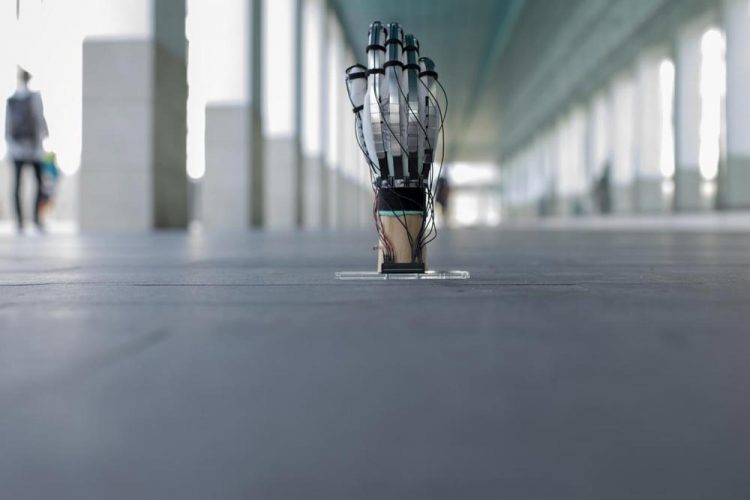Ultra-light gloves let users 'touch' virtual objects

The glove weight only 8g per finger. Credit: Marc Delachaux / EPFL 2018
Scientists at EPFL and ETH Zurich have just made a major step toward this goal with their new haptic glove, which is not only lightweight – under 8 grams per finger – but also provides feedback that is extremely realistic.
The glove is able to generate up to 40 Newtons of holding force on each finger with just 200 Volts and only a few milliWatts of power. It also has the potential to run on a very small battery. That, together with the glove's low form factor (only 2 mm thick), translates into an unprecedented level of precision and freedom of movement.
“We wanted to develop a lightweight device that – unlike existing virtual-reality gloves – doesn't require a bulky exoskeleton, pumps or very thick cables,” says Herbert Shea, head of EPFL's Soft Transducers Laboratory (LMTS).
The scientists' glove, called DextrES, has been successfully tested on volunteers in Zurich and will be presented at the upcoming ACM Symposium on User Interface Software and Technology (UIST).
Fabric, metal strips and electricity
DextrES is made of nylon with thin elastic metal strips running over the fingers. The strips are separated by a thin insulator. When the user's fingers come into contact with a virtual object, the controller applies a voltage difference between the metal strips causing them to stick together via electrostatic attraction – this produces a braking force that blocks the finger's or thumb's movement. Once the voltage is removed, the metal strips glide smoothly and the user can once again move his fingers freely.
Tricking your brain
For now the glove is powered by a very thin electrical cable, but thanks to the low voltage and power required, a very small battery could eventually be used instead. “The system's low power requirement is due to the fact that it doesn't create a movement, but blocks one”, explains Shea. The researchers also need to conduct tests to see just how closely they have to simulate real conditions to give users a realistic experience.
“The human sensory system is highly developed and highly complex. We have many different kinds of receptors at a very high density in the joints of our fingers and embedded in the skin. As a result, rendering realistic feedback when interacting with virtual objects is a very demanding problem and is currently unsolved. Our work goes one step in this direction, focusing particularly on kinesthetic feedback,” says Otmar Hilliges, head of the Advanced Interactive Technologies Lab at ETH Zurich.
In this joint research project, the hardware was developed by EPFL at its Microcity campus in Neuchâtel, and the virtual reality system was created by ETH Zurich, which also carried out the user tests.
“Our partnership with the EPFL lab is a very good match. It allows us to tackle some of the longstanding challenges in virtual reality at a pace and depth that would otherwise not be possible,” adds Hilliges.
The next step will be to scale up the device and apply it to other parts of the body using conductive fabric. “Gamers are currently the biggest market, but there are many other potential applications – especially in healthcare, such as for training surgeons. The technology could also be applied in augmented reality,” says Shea.
###
Press kit: http://bit.
Media Contact
All latest news from the category: Power and Electrical Engineering
This topic covers issues related to energy generation, conversion, transportation and consumption and how the industry is addressing the challenge of energy efficiency in general.
innovations-report provides in-depth and informative reports and articles on subjects ranging from wind energy, fuel cell technology, solar energy, geothermal energy, petroleum, gas, nuclear engineering, alternative energy and energy efficiency to fusion, hydrogen and superconductor technologies.
Newest articles

A universal framework for spatial biology
SpatialData is a freely accessible tool to unify and integrate data from different omics technologies accounting for spatial information, which can provide holistic insights into health and disease. Biological processes…

How complex biological processes arise
A $20 million grant from the U.S. National Science Foundation (NSF) will support the establishment and operation of the National Synthesis Center for Emergence in the Molecular and Cellular Sciences (NCEMS) at…

Airborne single-photon lidar system achieves high-resolution 3D imaging
Compact, low-power system opens doors for photon-efficient drone and satellite-based environmental monitoring and mapping. Researchers have developed a compact and lightweight single-photon airborne lidar system that can acquire high-resolution 3D…





















